Fogo Island projects were "an opportunity to use architecture to preserve tradition"
Interview: millionaire businesswoman Zita Cobb has used cutting-edge architecture and design to revitalise the economy of remote Fogo Island in Newfoundland, the place of her birth. She told Dezeen how she got international designers to work with local craftspeople "to preserve some of the things we were afraid of losing" (+ slideshow).
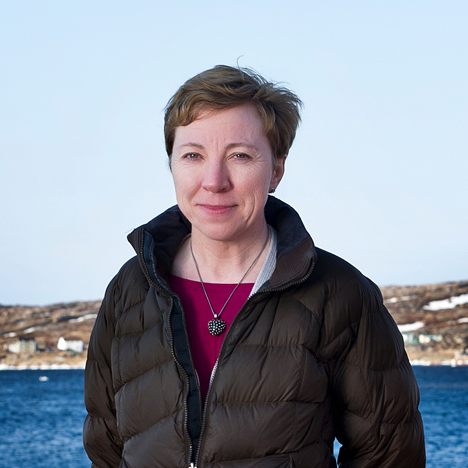
With an area of less than 100-square-miles and population of just over 2,000, Fogo Island now boasts a series of striking artists' studios designed by Canadian architect Todd Saunders and an inn furnished by leading international designers.
These were built by a foundation that Cobb established in 2001 to give islanders a viable economy after the collapse of its fishing industry.
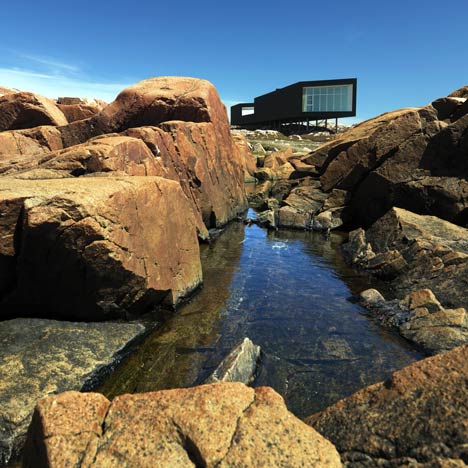
"We saw an opportunity to use architecture as a way to preserve some of the things we were afraid of losing in terms of traditional knowledge," said Cobb, 55. "To not just hold onto the knowledge, but actually extend it another 100 years."
Cobb grew up on the island. Like many, she moved away to study and didn't plan to return, but "never stopped caring about this place and believing deeply that it has a lot to offer".
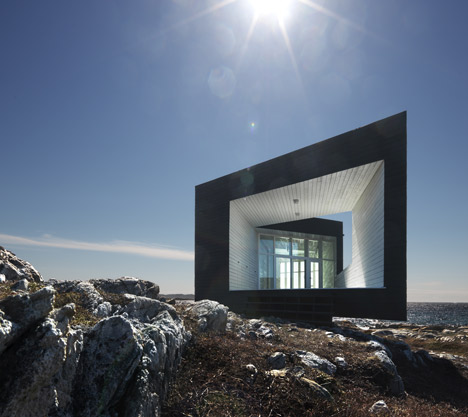
So after a successful career in the fibre-optics industry, she went back, determined to reverse the island's declining fortunes.
"If you think about Canada, or really everywhere, there is a crisis of rural people moving into urban areas at a much faster rate than ever before," she explained.
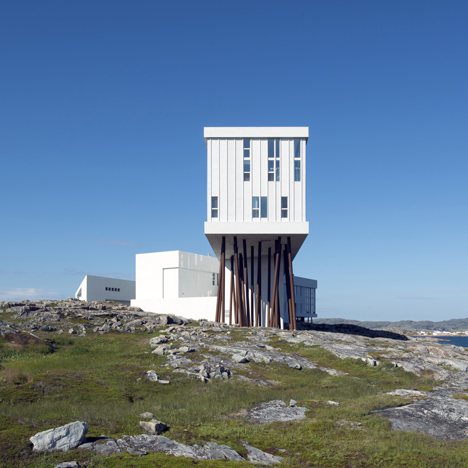
She founded the charitable Shorefast Foundation which, as well as providing funding for local business, helped Cobb launch an artists' residency programme called Fogo Island Arts that brings creatives from all over the world to work on the island.
"I think of it as a reweaving of Fogo Island into the fabric of the world in a new way," she told Dezeen. "I obviously am a big believer in the power of art to make all kinds of social impact."
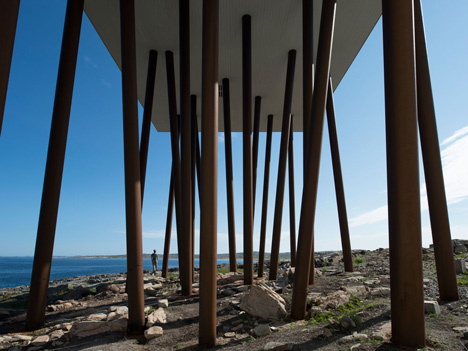
Cobb enlisted the help of Canadian architect Todd Saunders to design a series of artists' studios, which were built by islanders using traditional materials and techniques.
"Fogo Island is a very self-reliant place – everything we have we made ourselves and very little was ever brought to this island," she said. "All those skills are still here so we wanted to put them to use in the making of these buildings and do something handcrafted."
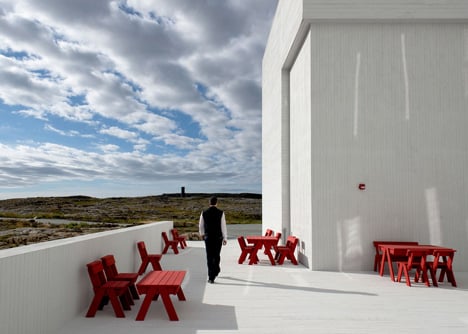
Saunders also designed Fogo Island Inn, which draws tourists to the island and serves as showcase for the artists' work. But rather than filling the inn with imported furniture, Cobb took the advice of London-based interior designer Ilse Crawford and set about sourcing everything from the local community.
A host of international designers, including Ineke Hans, Chris Kabel and Donna Wilson, were invited to design products that could be produced using local resources.
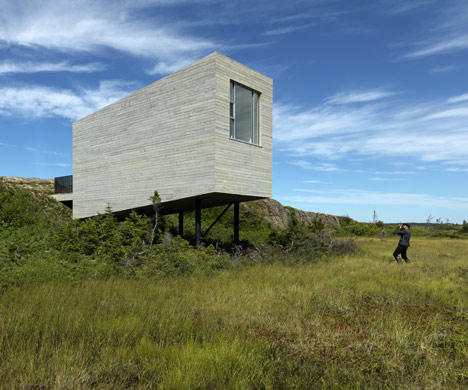
"We invited designers to come in for a residency and paired them up with local craftspeople, whether they be textile people or boat-building people, and asked them to come up with the objects that were needed," explained Cobb.
Many of these items will now be reproduced for sale, bringing an additional income to the community that could help to sustain it as the fishing industry declines.
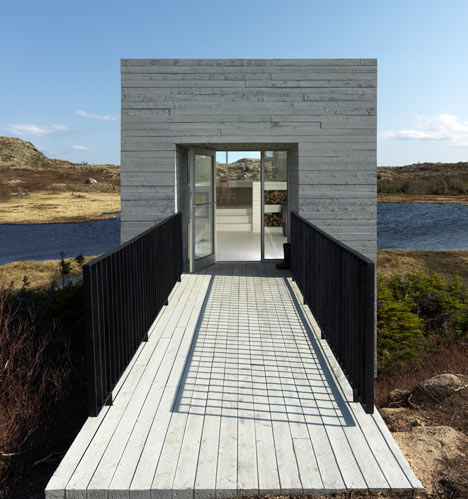
"We don't need to sell millions of anything, but selling 100 quilts makes a difference to Fogo Island's economy," said Cobb.
Scroll down for a full transcript of the interview:
Amy Frearson: Can you begin by telling me a little bit about your personal relationship with Fogo Island?
Zita Cobb: Well I was born and raised here. My cousins maintain that there have been eight generations of Cobbs on Fogo Island, but that all depends on how you measure a generation. I always think about the island as a ship, a little bit like Buckminister Fuller – the planet earth is a ship too, but this is the only ship I knew until I was 16. I am no different from any other islander, I have a very embodied and integrated relationship with this place. I know its every nuance and it knows mine.
I left here to go to university after high school and I took the place with me, of course. I think the analogy of the ship is a good one, because no matter where you go, you always know where that mothership is. The island is approximately 300 square kilometres and there are 10 settlements, outports we call them, and everybody settled on the coast of course, because they came to fish. I grew up on a farm and had never even been to the community five kilometres away, called Tilting, because we didn't have cars. We could have gone by boat but there was no reason to go, because there was everything you needed in your own village.
Amy Frearson: Is it still a car-free island?
Zita Cobb: Well no, not now, that has changed. I am 55 years old and when I was growing up it was a car-free island, but half of the roads came during the late 60s and early 70s.
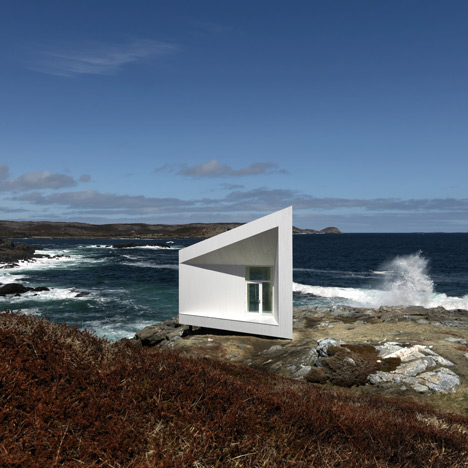
Amy Frearson: What are your memories of growing up on the island?
Zita Cobb: I always felt we had everything, but it was never a very wealthy place. It really is all about the weather here. Spring, summer and fall are times of gathering food. Whether you were fishing or berry picking, you spent that part of the year working really, really hard to get the food you needed for the winter. Come November, December, when the pack ice came, you knew you were going to be cut off for months. Boats were not able to go to sea anymore because of the ice. The frightening part of that wasn't so much that we would run out of food, although there were winters when you wondered, but it was about if someone got sick. If that happened, there was no possibility of getting off the island. When I grew up as child there was always that sort of dread, for example, in the old days we would dig graves in November because the ground would freeze and if someone died in winter, you couldn't dig a grave. We would dig these graves and would always be wondering, "is this for me?" or "is this for you?"
I think people who live on islands understand practicality better than anyone. I'm also a sailor and when you are in the middle of the ocean, you deeply understand that you need to keep this little ship healthy and in good shape because if that little ship fails, you're not going to make it. If you live on an island, it's the same thing. People are acutely aware of their environment, of any changes or nuances in anything. The wind, the way the ice moves, everything. I don't think it's just a matter that we love the island, I think it's that we know our survival depends on it.
Amy Frearson: Did you always plan to return to Fogo Island after university?
Zita Cobb: No. When I left, in the mid 70s, the cod fishery had collapsed and my father, who was quite old then anyway, was beyond fishing. He really was very brokenhearted that on his watch our continuity here was going to end. So, when I left, I didn't imagine I would ever be able to return.
I think my road to coming back was really because of two things. Number one, I never stopped caring about this place and believing deeply that it has a lot to offer me and others. But I also started to realise that small islands are very relevant to the big island we call earth and the business models that have allowed Fogo Island to survive from the 60s have lots of implications for small communities. If you think about Canada, or really everywhere, there is a crisis of rural people moving into urban areas at a much faster rate than ever before.
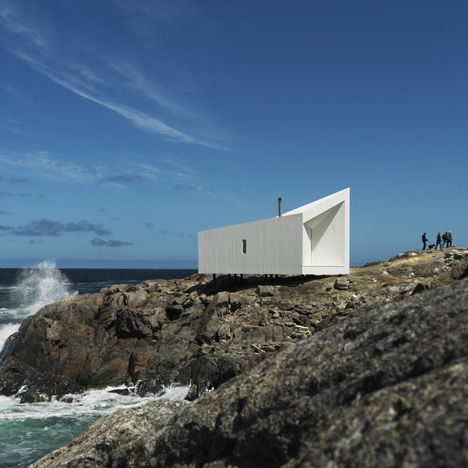
Amy Frearson: Can you tell me a bit about the organisations you have established on the island since you returned, and what prompted you to start these up?
Zita Cobb: I think that the way we have started our projects here has something to offer in terms of learning how can a rural place be relevant and how can we forge productive relationships between rural places and urban places. Nature and culture are the two great garments of human life. I think human culture emerges mostly out of the relationship and sometimes struggle between human beings and nature. And so nature and culture largely exist at the periphery of these rural places, whether they are farming places or fishing places, while business and technology largely live in urban places, and so the question becomes how can we use business and technology to serve nature and culture.
So the first thing we did was set up something called Shorefast Foundation, which is a charitable organisation, but we recognised that a charity itself is not sustainable so the question became how can we could use the fund and do things in a business-like way to help sustain it. So we did several things. First of all we started Fogo Island Arts – a separate not-for-profit organisation. This is a residency programme and a dialogue organisation for contemporary art. I think of that as a reweaving of Fogo Island into the fabric of the world in a new way. I obviously am a big believer in the power of art to make all kinds of social impact. Then we had some straight-up preservation initiatives to try and hold on to some of the heritage of the island. We also started something called the Business Assistance Fund, which is like a lending fund for local people to start or expand local businesses. Then of course the economic engine of the whole thing is the Fogo Island Inn that opened last year. The idea of the inn is that any surpluses, and god willing there'll be lots of them, will go back into the charitable organisation and stay in the community.
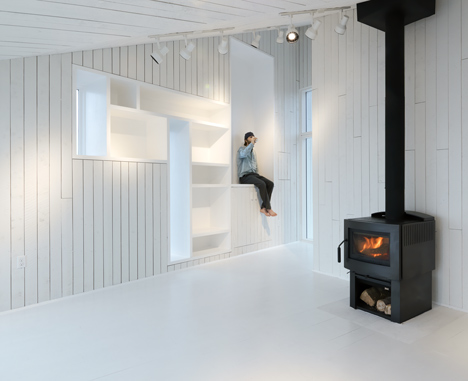
Amy Frearson: How did the architectural side of the projects develop, and how did you first start working with Todd Saunders?
Zita Cobb: When we started the project we realised that we were going to need studios for artists to work in and were going to need an inn. We saw that as an opportunity to use architecture as a way to preserve some of the things we were afraid of losing in terms of traditional knowledge, but to build it into something that is very contemporary and has the potential to not just hold onto the knowledge, but actually extend it another 100 years. Fogo Island is a very self reliant place – everything we have we made ourselves and very little was ever brought to this island. All those skills are still here so we wanted to put them to use in the making of these buildings and do something handcrafted. We wanted to to work with someone who could not just understand, but deeply accept the responsibility that the project had.
Todd Saunders, to start with is an islander, so he has that cultural, historical burden from his own lineage to serve this place well. He had the skills and the sense of duty, so that was what brought us together. He was up for that kind of journey. We really did this in such a deeply collaborative way and everybody needed to understand how to make compromises for each other.
Amy Frearson: What other designers did you work with?
Zita Cobb: When we started the interiors for the project we realised we needed objects that simply did not exist in our culture before, like chandeliers for the inn. One of the smartest things we did was to get help from interior designer Ilse Crawford. The advice she gave us was to have everything for the inn designed and made on the island. So we invited designers to come in for a residency and paired them up with local craftspeople, whether they be textile people or boat-building people, and asked them to come up with the objects that were needed. This became a really interesting project that went on over a three year period. Donna Wilson was one of them. She designed a number of things including some wallpaper for the inn, and Ineke Hans also worked on a number of objects.
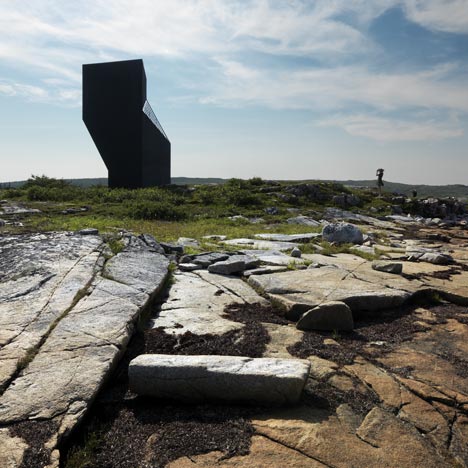
So when we started building the inn we set a couple of rules for ourselves. The first was that wherever possible, things needed to be made on Fogo Island. Another was that under no circumstances would we buy anything, but if we had to it should be from places with basic labour laws and basic environmental protection laws.
Amy Frearson: So you applied these rules to ever detail in the inn?
Zita Cobb: Even the nails! We wanted to offer people who were staying at the inn at least what the cavemen had. There needs to be fresh air, so you can open a window anywhere in the inn. We wanted to offer a warm hearth with which to gather wood, so there are 36 wood-burning stoves and fireplaces. We wanted to make sure that everything is made of a natural material. And of course we wanted to bring the companionship of others.
Amy Frearson: Can you tell me more about the artists' studios?
Zita Cobb: The thing about these artists' studios is that they are located off the grid. You have to walk to them, you can't drive to them, and that was deliberate. But they are within a ten or fifteen minute walk from communities, so we wanted to make sure they would feel "of the place". It was kind of the test for all the buildings – if someone who lived here 200 years ago came back, could they recognise them as something of their own, even though it's very contemporary?
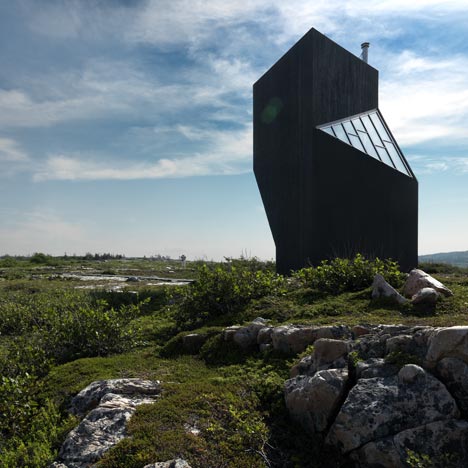
Amy Frearson: How has the presence of artists on Fogo island changed the community?
Zita Cobb: I wouldn't say changed, changed is a strong word. It has added to the community capacity for sure. It has brought a different kind of awareness into the community of the outside world. I think these artists, who are mostly young, have a specific point of view about the world and I think the conversations help Fogo Islanders understand things from outside of their experience here.
There are fascinating projects and fascinating conversations, for instance a Scottish artist, Rory Middleton, did a really lovely project on a pond where he made a cinema of ice and used it to play a movie of a sunset. On a very simple level, his project was about how everything, even our experience of sunset, has become mediated. It worked at many different levels, but you can see how that could be very thought provoking.
Amy Frearson: Do you have other plans for the future of Fogo island?
Zita Cobb: One of the things that we're doing in the background is trying to make a toolkit of the things we've learned that we can share with other rural places that are trying to find their way. Extracting the learnings and sharing them is an important priority for us. We also think that all those objects in the inn, from the chairs to the quilts, have the potential to fortify the economy of this place. So we want to launch a little business that sells those objects. We don't need to sell millions of anything, but selling 100 quilts makes a difference to Fogo Island's economy.
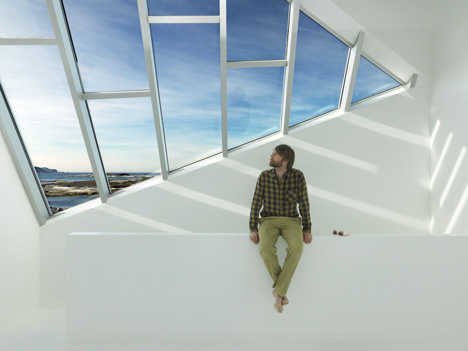
Amy Frearson: So there is a real opportunity to bring a lot of business to the community?
Zita Cobb: Absolutely. When people stay at the inn, it is unbelievable how they respond. Something happens when people go into these rooms, they don't want to come out. I think when things are handmade, it kind of helps repair our broken relationship with objects and it brings possibilities.